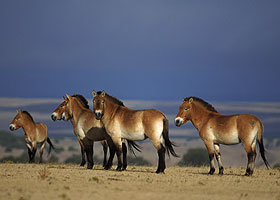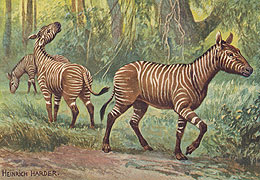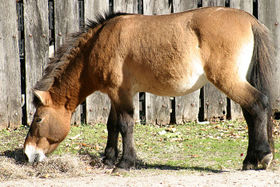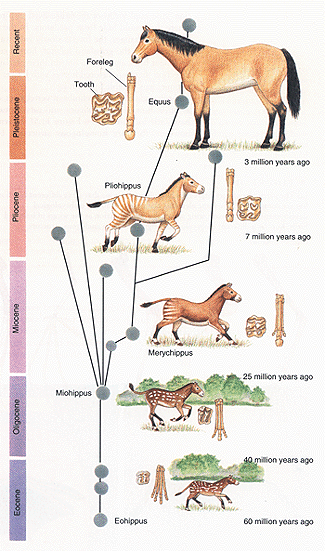Horses and Cryptozoology
Posted by: Loren Coleman on October 10th, 2008
Horses and cryptozoology? Who would ever think there might be any kind of overlap between those two? An exhibition at the American Museum of Natural History could have informed folks of one of the linkages, but did it?
When I spoke at the American Museum of Natural History last year, giving a talk on the “Introduction of Cryptozoology,” during the “Mythic Beasts” exhibition, I was approached by a volunteer who was assisting with the then-forthcoming “Horses” program. I was asked if I’d be able to help with gathering more data on Ivan T. Sanderson’s statements about the survival of horses in the Americas. Of course, I said “Yes,” but the AMNH never followed through on their contact and research.
What the AMNH museum individual was pinpointing was the theory that Sanderson had considered regarding the possibility that horses never became extinct in the “New World.”
Ivan T. Sanderson, once wrote: “There is a body of evidence both from the mainland of Central America and even from rock drawings in Haiti itself tending to show that the horse may have been known to man in the Americas before the coming of the Spaniards.” Science, 93, 507 (May 30, 194; p. 91).
As far as I have been able to determine, the AMNH’s exhibition “Horses” does not consider this notion in its exhibition. Maybe I’m wrong, as I have only been able to view the program online. Have you seen the exhibition and read if the Sanderson material is in the mix?
(Needless to say, I’ve also discussed Przewalski’s horses here and here, which is an oft-forgotten “horses and cryptozoology” topic too.)
The AMNH exhibition looks like a good program, now in New York City, from May 17, 2008, through January 4, 2009, so if you visit it and find anything cryptozoological in it, let us know.
About Loren Coleman
Loren Coleman is one of the world’s leading cryptozoologists, some say “the” leading living cryptozoologist. Certainly, he is acknowledged as the current living American researcher and writer who has most popularized cryptozoology in the late 20th and early 21st centuries.
Starting his fieldwork and investigations in 1960, after traveling and trekking extensively in pursuit of cryptozoological mysteries, Coleman began writing to share his experiences in 1969. An honorary member of Ivan T. Sanderson’s Society for the Investigation of the Unexplained in the 1970s, Coleman has been bestowed with similar honorary memberships of the North Idaho College Cryptozoology Club in 1983, and in subsequent years, that of the British Columbia Scientific Cryptozoology Club, CryptoSafari International, and other international organizations. He was also a Life Member and Benefactor of the International Society of Cryptozoology (now-defunct).
Loren Coleman’s daily blog, as a member of the Cryptomundo Team, served as an ongoing avenue of communication for the ever-growing body of cryptozoo news from 2005 through 2013. He returned as an infrequent contributor beginning Halloween week of 2015.
Coleman is the founder in 2003, and current director of the International Cryptozoology Museum in Portland, Maine.
















If Horses Never went Extinct (well some varieties)
then that’s amazing. 🙂
i would love to see those prehistoric horses in zoos. ;0
There are quite a few who believe that horses never went completely extinct in the Americas. Recent DNA studies indicate that the modern (“cabelline”) horse evolved here before it then migrated to Eurasia acrosss the Bering land bridge. Some Native American tribes insist that they “always” had horses, even before Europeans ever came to North America. For instance, there are people think that the original Appaloosa horses of the Nez Perce tribe of the American West are a remnant of the original horses of the Americas.
There are several ways in which the Appaloosa breed differs from other breeds of horses. Some of the physical characteristics most Appaloosas have are mottled skin, vertically striped hooves, a visible white sclera which encircles the iris of the eye, and a short, rather sparse mane and tail. While it’s generally accepted that the Nez Perce first acquired their horses from Spanish explorers in the 15th century, some people believe that the differences evolved in isolation during the 10,000 years or so since that remnant population became separated.
Even if it’s true that horses became completely extinct here at the end of the Pleistocene, the fact that the modern horse actually evolved here should be reason enough to consider the wild horses as native American wildlife, and not “introduced ferals”.
I didn’t know of Sanderson’s theory. Very interesting.
I covered Przewalski’s horse and the tarpan in my two books (Rumors of Existence, 1995, and Shadows of Existence, 1996) and, in a lesser known story, the discovery of two heretofore unknown populations of unique breeds (one quite primitive in appearance) in Asia. My article “The Unknown Horses” appeared in my newsletter Exotic Zoology and in my latest book.
Sorry I will not be in NY for this exhibition.
Here’s what may be the most obvious crypto question about horses- Bucephalus, Alexander the Great’s horse reputedly had 3 toes rather than a single hoof per foot. Unless it was a genetic aberration bringing out an ancestral trait how would the folks of that day and age have known about three toed horses? Is there any kind of general consensus about this?
There is “scientific” evidence horse and man were together in NA. Their bones are found together~10-15000 years back, and the horse bones indicate they were eaten by man. See the book Horses and Humans: The Evolution of Human-Equine Relationships. North American humans hunted horses, and may have tamed some, but apparently did not control breeding. If horse did not go extinct in North America, they were in short supply. I attended the AMNH exhibition “The Horse.” Great recreations of horses of the past.
I’m not sure why swgustafson felt the need to put quotes around the word scientific, unless it was for emphasis. Yes, North American horses were a prey animal for early Native Americans on this continent. It is precisely the evidence for the utilization of horses as prey animals that best argues against Sanderson’s hypothesis – to the best of my knowledge as an archaeologist, Equus remains are not found between the end of the last ice age and the 15ht century CE in any well-documented archaeological deposits on this continent. If horses survived up to the 15th century, then they didn’t leave any physical evidence behind that we know of.
Looks like a neat exhibit though, and it would be interesting to see more about Sanderson’s claims.
Makes my toes curl to see this beautiful exhibition and imagining riveting displays and dioramas-of beautiful horses in pristine environments. My first hands on contact was working with cart horses, who had there own massive charm.
I have the feeling that we still have the potential for the excitement and satisfaction of experiencing some of these spectacular scenes, having as we do samples of very ancient breeds. I do feel they are not appreciated as they should be.Two come to mind first the Exmore pony virtually unchanged since prehistory. Strangely having the same unusual dentition as prehistoric horses (and I believe other features) who’s remains are found in the soil of Alaska! Perhaps the American horse IS still alive in this way! But no curly coat.
Another is the beautiful Sorraia horse who again as far as I’m aware doesn’t receive the attention it deserves. Though to be fair it does manifest itself in the mustang. The latter of course must in many respects in its freedom give a reminder of its really wild ancestors.
Mattebille mentioned two new asian horses one presumably, being the Riwoche horse from Tibet, which ought to be of high interest to cryptozoologists having an appearance similar to ancient cave drawings of horses. I have tried to get more information about this horse, without success, as DNA testing was proposed by Michael Peissel who found this horse in Tibet. I’m surprised it was not on this site until today (by Mattebille). Will gratefully look at his site for more information.
I expect there are others almost unchanged or with that potential (including the Koenig come Tarpon). These creature do complement and grace nature reserves, where their grazing to maintain environments is valued.
I wonder if the exhibition does justice to these living treasures as it does to the ones that have gone. Even though ancient living horses are among us they can still give us that cryptozoological sort of thrill and satisfaction. Do they not merit the same care as is given to the Przewalski horses?
And let’s not forget the Kigers in the Steens Mnt. area of Oregon, perhaps the most remote and “pure” breed of horse.
Yes your right, don’t forget the kiger a version of the sorraia. Wonderful horses and there is a link with the tarpon. There is also a route back to having some real naturally wild horses as important as przewalskis and as interesting but to my mind more beautiful. Maybe, maybe like their lost American ancestors!
I went to the exhibition (review below). I think it is intended to travel: it may show up at museums in other cities next year.
No mention of Sanderson’s idea that “native” American horses might have survived, though.
Very good exhibition: I think I spent over three hours there, on two visits, and i don’t think I exhausted it. I was lucky to go with a relative who knows horses inside and out (literally: has studied equine anatomy and works on a horse farm) who could explain fine points to me.
Five mounted horse skeletons (six if you include a “Hyracotherium” fossil: the rest are all modern), including the AMNH’s famous mount of a rearing horse with a man reaching up to it, and also side by side skeletons of a Shetland Pony and a Shire (? anyway, one of the huge draft breeds). Some video loops worth lingering in front of: a slow-motion of the feet of a galloping horse that lets you see how the foot flexes, and two interviews, one with an archeologist studying early horse domestication somewhere in the former Soviet Union, one with Bruce McFadden (author of the most recent general book on horse evolution, called, I think, “Fossil Horses”) on the isotopic study of fossil teeth to verify diets of extinct species. A general instructional display on horse anatomy. A selection of saddles and tack, with informative captions. Medieval armor for a horse and its knight. Going through in order (the floor-plan of the exhibit and the fact that entrance and exit are at opposite ends encourages this), about the first half is devoted to horses as biological entities, the second to horse-human interaction through history. It being the AMNH, it needs at least one “habitat group” (life-size diorama): that’s what the third picture in Loren’s column shows: three reconstructed extinct species, all three-toed.
If you go to see it in New York: it’s on the same floor as the AMNH’s vertebrate paleontology halls, and the fossil mammal hall has a series of horse mounts (Hyracotherium to Equus) and, in an alcove, a fossil of a late Miocene mare and foal that died from complications of a breach delivery.
For everyone who’s interested in Przewalski Horses and their reintroduction in Mongolia, the foundation that initiated the project published a beautiful book in 2006: The Tale of the Przewalski Horse: Coming Home to Mongolia by: Wit, P. & I. Bouman.
For a description, look here.
Loren, you may also want to look up one Yuri Kachinsky (The Mystery Of The Indian Pony), in Toronto , to see if he has come across any further evidence. Few of his sites are still on the web (How Did The Horse Get To America), however many of his post can still be found in Usenet discussion groups.
This subject really needs to be looked in to more deeply.
I understand that some members of the Yakama Nation believe that, “the horse was always here…even before the Spanish arrived”.
Also, it was once rumored that the author, Hardy Oelke (of Sorraia Horse fame) once identified a group of horses in the USA’s Spanish Mustang Registry, and in one wild herd (the Mt. Home management area), with a peculiarly type of Mt DNA that could not be accounted for by European imports. It was then being referred to as the “mystery” Mt DNA. Wonder whatever became of this early research? I recall hearing that these animals were taken into the Sorraia Mustang Project, based on their strangely primitive appearance, even though the Iberian Sorraia possessed a different form of Mt DNA.
More on Hardy Oelke, and America’s Sorraia Mustangs, here and here.
The Spanish Mustang Registry, here.
The Mt Home horses, here.
(They do remind me more of tarpans, than mustangs.)
There’s a really good article in the North American Biofortean Review (Vol.2, No. 3, Issue 5 – December 2000) by Yuri Kuchinsky. There are actually a lot of articles and they are all interesting, but if you click on “Indian Pony Mystery” you get a terrific in-depth article chock-full of well-reasoned theory and conclusions that support the idea that horses never quite left North America. It’s a great read.